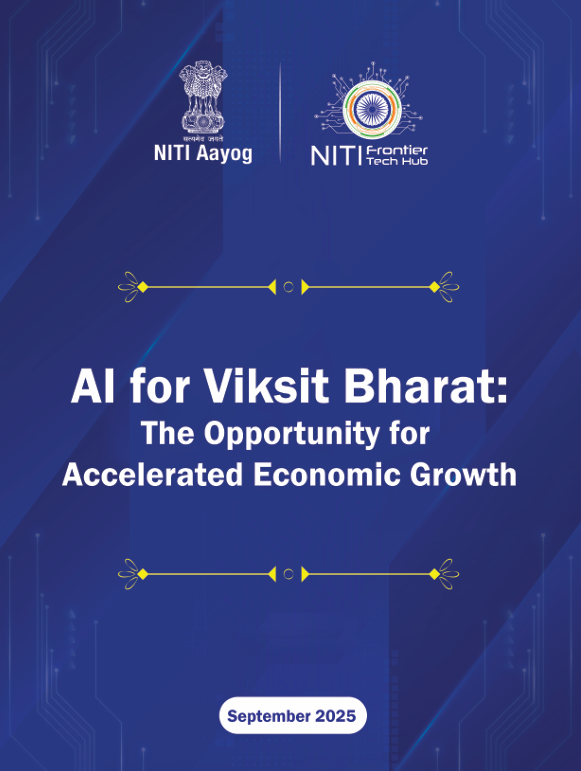NITI Aayog’s latest report, AI for Viksit Bharat: The Opportunity for Accelerated Economic Growth, makes a bold proposition: artificial intelligence is not a peripheral tool but a decisive lever in India’s ambition to become a developed nation by 2047. At a time when the global AI economy is projected to add between $17–26 trillion over the next decade, India has a unique opportunity to capture nearly 10–15% of this value. With a strong STEM workforce, an expanding R&D base, and robust digital infrastructure, the report positions AI as central to bridging the gap between India’s current 5.7% growth trajectory and the aspirational 8% GDP growth required under the Viksit Bharat vision.
A ROADMAP OF TWO LEVERS
- The report identifies two critical “levers” through which AI can accelerate India’s growth:
1. Accelerating AI adoption across industries – Embedding AI in core sectors such as banking, manufacturing, healthcare, and agriculture to drive productivity and efficiency. This alone could bridge 30–35% of the growth gap, potentially contributing $500–600 billion to GDP by 2035. - Transforming R&D with generative AI – Leveraging AI to leapfrog traditional, capital-intensive research pathways, especially in pharmaceuticals, automotive engineering, and next-generation services. This could yield an additional $280–475 billion in GDP impact.
Together, these strategies not only enhance efficiency but also position India as a global hub of AI-driven innovation.
THE STRATEGIC ENABLERS
The report stresses that India’s AI journey cannot be realized without a foundation of enabling conditions:
- Infrastructure: Public AI infrastructure—such as high-end GPU clusters under the IndiaAI Mission, federated cloud systems, and sectoral data platforms—is vital. Initiatives like AI Kosh (already hosting over 2,000 datasets) must evolve into trusted, innovation-ready data commons.
- Governance: Robust AI governance frameworks—ethics guidelines, explainability standards, risk-based audits, and compliance toolkits—are essential for building public trust and ensuring responsible deployment.
- Skilling and Workforce Transformation: By 2035, India aims to train over 50 lakh students and professionals in AI, foster PhD-level research, and establish specialized programs in finance, law, and manufacturing. This is a recognition that technological transformation is meaningless without human readiness.
- Collaboration: The government, private sector, and academia are seen as equal partners in shaping India’s AI future. Sandboxes for experimentation, public–private partnerships for R&D, and academia-led innovation ecosystems are emphasized throughout.
POTENTIAL OUTCOMES: INDIA’S AI FUTURES
The report outlines four ambitious outcomes for India if the roadmap is executed well:
- India as the data capital of the world – By leveraging sovereign, privacy-preserving data platforms across finance, genomics, manufacturing, and mobility, India can turn its demographic and digital depth into a competitive advantage.
- An adaptable AI-skilling ecosystem – With portable lifelong learning accounts, AI Open Universities, and mandatory AI literacy across industries, India could close its skill gap with global leaders.
- Targeted AI adoption across sectors – Strategic use in financial services, manufacturing, pharma, and automotive industries together contributing 25% of India’s projected 2035 GDP can catalyze sectoral growth.
- Future-proofing jobs – By preparing for occupational shifts, reskilling millions, and protecting gig workers under the Code on Social Security, India can mitigate displacement risks while harnessing AI-driven opportunities.
A LEGAL AND POLICY LENS
What makes this report particularly relevant from a technology law perspective is its recognition that AI growth cannot be de-linked from regulation. As global frameworks such as the EU AI Act reshape trade conditions and compliance norms, India’s ability to define its own AI governance structures will determine both domestic resilience and international competitiveness. The IndiaAI Mission’s seven pillars, compute, innovation centres, datasets, application development, future skills, startup financing, and safe AI reflect a conscious attempt to integrate legal safeguards into technological development.
In practice, this means India must navigate a careful balance: ensuring inclusive access for MSMEs and underrepresented regions, while embedding explainability, privacy, and accountability into AI systems. Without such safeguards, the report cautions, productivity gains could be overshadowed by social risks such as job losses, data misuse, or systemic bias.
INDIA’S AI MOMENT
The report leaves no doubt: achieving Viksit Bharat requires decisive, accelerated AI integration across the economy. Yet it also warns against complacency. Global competition, evolving trade regimes, and the pace of technological disruption mean that India must act with urgency and foresight.
AI is not presented merely as a tool for efficiency, but as a national growth engine—a chance for India to redefine its role in global value chains, unlock inclusive prosperity, and establish itself as a leader in responsible technology governance. If realized, this vision could ensure that India does not just adapt to the AI revolution but actively shapes it on its own terms.

